This review covers military events that took place on the territory of Belarus in May 2023. The information is provided as of June 1, 2023.
Summary
The following types of combat training activities were conducted in the Belarusian Armed Forces in July:
Field drills — in the 740th Anti-Aircraft Missile Regiment, the 1st Anti-Aircraft Missile Regiment, the Anti-Aircraft Missile and Artillery Divizion of the 120th Mechanized Brigade, reconnaissance units of the North-Western Operational Command of the Belarusian Armed Forces.
Training sessions — in the 51st Artillery Brigade (on the use of software for reconnaissance, control and adjustment of artillery fire), with company commanders and their deputies of the Special Operations Forces units, with battalion and divizion commanders of the Western Operational Command (issues of interaction of troops with artillery, unmanned aerial vehicles (hereinafter — UAVs) and engineering units, installation of mine and explosive barriers).
The general activity of the Belarusian Armed Forces didn’t change significantly in May. The main efforts were still focused on maintaining the readiness of individual elements of national security (units and formations of the Belarusian Armed Forces, territorial defense, etc.).
Currently, there are no reasons to assume that combat training of the Belarusian Armed Forces will become less intensive in the near future.
The Russian component of the joint regional group of troops of Belarus and Russia continues to be stationed at the training grounds of the Belarusian Armed Forces. About 4500 servicemen of the Russian Armed Forces could be stationed at training grounds and airfields in Belarus. In general, we can note a change in the pattern from the reduction of the Russian contingent in Belarus to its insignificant expansion. This was caused by a new rotation of part of the forces and equipment of the Russian Armed Forces in May, and new redeployments of troops from Russia to Belarus.
The general medium-term forecast for the development of the military situation in Belarus remains unchanged: there are no reasons to expect an offensive operation by the Russian Armed Forces from the territory of Belarus. Russia is still using the deployment of the regional group of troops to train its military, as well as to restrain part of the Ukrainian forces along the border with Belarus. At the same time, the Belarusian Armed Forces are not capable of conducting an offensive operation against Ukraine on their own (without the support of the Russian Armed Forces).
As noted in the March review, currently the key destabilizing factor that could change the current military situation in Belarus is the possible deployment of tactical nuclear weapons on the territory of the country.
Chapter 1. The Armed Forces of the Republic of Belarus (hereinafter – the Belarusian Armed Forces)
1.1 Combat training.
Key points on paragraph 1.1:
- Various combat readiness inspections continue to be conducted.
- Reservists are constantly involved in combat training. In total, at least 1200 reservists were drafted for various training sessions in May. The total number of reservists who underwent military training sessions during the five months of 2023 can be estimated at 7500-8000.
- There were almost no reports on the combat coordination activities of the Belarusian and Russian units of the regional group of troops. The Belarusian and Russian military continue to perform combat training separately.
- There were no reports on intensive combat training activities of the internal troops and border guard agencies in May.
1.1.1 The main activities of combat training.
The Belarusian Armed Forces conducted combat training activities less actively in May. This was caused by the draft of conscripts for active military service. Therefore, part of the efforts of the Belarusian Armed Forces was focused on initial military training of recruits.
There were no reports on company (battalion or brigade) tactical drills, tactical special and command staff drills, field drills, staff and command staff training during the month.
We note that another stage of the comprehensive inspection of combat readiness of the Belarusian Armed Forces was held in May. A number of units of the Belarusian Armed Forces were involved in the inspection. For example, a draft of persons liable for military service for military training sessions was held at the 38th Air Assault Brigade (see paragraph 1.1.3 of Chapter 1). Belarusian and Russian crews of combat aircraft performed tasks to patrol the Belarusian airspace. During the flights, they practiced patrolling and mutual cover tasks.
Units of the 336th Rocket Artillery Brigade and the 465th Missile Brigade of the Belarusian Armed Forces were also involved in the inspection. The units marched long distances to designated areas. During the march, the issues of air cover of equipment in cooperation with units of unmanned aerial vehicles (hereinafter — UAVs) were practiced. The issues of planning a fire attack on a potential enemy, as well as the preparation and launching of missile strikes, were practiced. It was noted that a combined missile and artillery battalion, consisting of Polonez multiple launch rocket systems (hereinafter — MLRS) and Tochka-U tactical missile systems, had been formed for the first time. They practiced launching missile strikes at the abandoned Ros airfield, 40 kilometers from the border with Poland. On May 17, the units returned to their permanent deployment point.
The 52nd Tank Battalion and the 202nd Mechanized Battalion of the 6th Mechanized Brigade, the rocket division of the 111th Artillery Brigade, and units of the national home guard also took part in the inspection (see paragraph 1.3.3 of Chapter 1).
We should also note other combat training activities:
- A training session with UAV operators at the 927th UAV training and operations center. Participants practiced aerial reconnaissance, navigation under electronic warfare, and artillery strike adjustment.
- After the downing of four aircraft of the Russian Aerospace Agency (Su-34 bomber, Su-35 fighter and two Mi-8 helicopters) in Bryansk oblast of Russia on May 13, the Air Defense Forces of the Belarusian Armed Forces were put on high alert. At the same time, officials of the Ministry of Defense of Belarus have repeatedly announced earlier that the Air Defense Forces would be put on enhanced combat duty.
- Servicemen of the 339th Mechanized Battalion of the 120th Mechanized Brigade additionally receive a related qualification as an operator of the Igla portable anti-aircraft missile system.
- A training on the topic “Interaction between military units and investigators during scene investigations as part of combat operations” was conducted. During the training, a training situation was simulated on the seizure of a settlement by an illegal armed formation. After the village was liberated from the conditional enemy, the investigators inspected the scene and documented war crimes.
- From May 29 to June 2, drills are conducted with the military administration and military units of technical support to practice the provision of missiles and ammunition to units, increase the survivability of technical support forces, and eliminate the consequences of missile and air strikes. Persons liable for military service drafted into military technical support units also take part in the drills.
- During the test training on the control of missile strikes, a unit of the 465th Missile Brigade armed with the Iskander-M missile system practiced preparing and launching missile strikes with standard and special (nuclear) weapons.
- The Air Defense Forces are removing 23-mm ZU-23-2 anti-aircraft autocannon from storage to perform tests and training with practical shooting.
Despite numerous statements about an active adoption of the experience of combat operations in Ukraine, the Belarusian Armed Forces still conduct training formally. This situation is well illustrated by the training of servicemen to fight armored vehicles of the potential enemy with small arms.
We should also note that there were almost no reports about joint combat training activities of units of the Belarusian and Russian contingents of the regional group of troops in May. This additionally confirms that the regional group of troops is needed solely for the training of the Russian military on the territory of Belarus.
1.1.2 Specifics of combat training of other security forces.
No significant events in combat training of the internal troops and border guard agencies were recorded in May. As for combat training activities, we can note that the officers of the 6th Militia Brigade of the internal troops underwent commander’s training. The servicemen practiced the use of UAVs, improved their skills in conducting fire at night, and the procedure for first aid in combat.
1.1.3 Training sessions with reservists.
Training sessions with reservists continued in May.
For example, it was reported that up to 1000 reservists were to be drafted from the reserve as part of the combat readiness inspection. It’s known that 500 of them were drafted for training sessions into the 38th Air Assault Brigade from May 2 to May 19. The conscripts from Brest, Homiel, and Hrodna regions were drafted into the brigade. It’s not known where exactly other 500 reservists were drafted into.
The purpose of the training session in the 38th Mechanized Brigade is to restore and improve the practical skills of persons liable for military service. At the training session, the reservists were to get acquainted with new models of weapons and military equipment and take part in training and drills. The reservists were trained in combat training disciplines, including tactical medicine. It was noted that the training was based on the experience of the war in Ukraine.
Later, company tactical drills were held with the reservists. During the drills, they practiced defensive actions, searching and destroying sabotage and reconnaissance groups of the conditional enemy. It was also reported that a battalion control tactical training was conducted with the reservists. During the training, they practiced taking control over the area of operations and maintaining order in it, organizing reconnaissance, and taking infrastructure facilities under protection and defense in cooperation with local authorities, militia and border guards.
It’s also known about the training with reservists in the 191st Artillery Group of the 19th Mechanized Brigade (training session on maintenance of weapons, military and special equipment), the 25th missile and artillery weapons arsenal (at least 12 reservists), the 111th Artillery Brigade (at least 10 reservists), and the 43rd missile and ammunition arsenal.
It was reported that the reservists were sent to the military training sessions by the military commissariats of the Cherykau and Krasnapollie districts, Mstislaul district, Mahiliou city and Mahiliou district, Pruzhany district, Svietlahorsk and Aktsiabrski districts, Savietski district of Minsk (at least 9 reservists; after passing the training session, some reservists will be certified for the military rank of lieutenant in reserve). We note that the number of reservists taking part in the training session mentioned above is unknown.
It was also reported that representatives of the 72nd training center selected at least 70 persons liable for military service in the military commissariat of the Rechytsa and Loyeu districts. This means that in the near future, the training center should hold a training session with the reservists. According to our information, training sessions at the 72nd training center are to be held from June 6 to June 30. The selection of reservists for military training sessions was also held at the military commissariat of the Bialynichy and Kruhlaye districts.
It was also reported that about 200 reservists were drafted for training sessions of the territorial troops (see paragraph 1.3.3 of Chapter 1).

Thus, the number of reservists drafted for training sessions in May can be estimated to be at least 1200 people. In total, at least 6810 people were drafted for various types of training sessions from January to May 2023. This is a minimum value, since there is no data on the number of conscripts drafted from the reserve for a number of training sessions. In reality, the total number of persons liable for military service who participated in military training sessions during the first 5 months of 2023 could be estimated at 7500-8000.
It was previously reported that a total of at least 9000 reservists would be drafted for various training sessions in 2023. Thus, the annual plan of drafting reservists for military training sessions has been completed by 80% for 5 months of 2023.
1.2. Movements of military equipment. Aviation activity.
Key points on paragraph 1.2:
- The intensity of movements of columns with equipment of the Belarusian Armed Forces decreased slightly compared to April.
- The intensity of movements of the Belarusian Armed Forces by rail also decreased compared to April.
- There was a slight increase in flight activity of the Belarusian Air Force.
- The general nature of movements of the Belarusian Armed Forces doesn’t allow us to conclude that troops are being concentrated to commit an act of aggression against Ukraine.
1.2.1 Movements of military and combat equipment by road
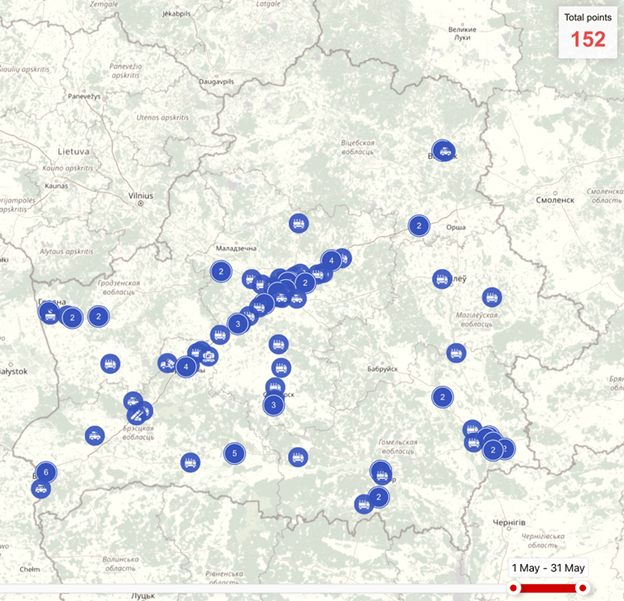
The intensity of movements of both military and combat vehicles of the Belarusian Armed Forces decreased slightly compared to April. In general, the movements of equipment recorded during the monitoring were connected with daily activities of military units, as well as with the new stage of combat readiness inspection (see paragraph 1.1.1 of Chapter 1). We can distinguish the following main routes of equipment’s movements: Minsk-Baranavichy, Minsk-Salihorsk, Barysau-Minsk, Lahoisk-Minsk, Zhodzina-Homiel, etc. Military equipment was also recorded in the following towns and cities: Brest, Homiel, Baranavichy, Vitsiebsk, Minsk, Barysau, Mazyr, Hrodna, Luniniets, etc. The highest activity of equipment’s movements was recorded in Brest region (on the М1 highway and near Brest, Baranavichy, Luniniets), Minsk region (on the М1, М3, М5, М6, R23, R53 highways, MKAD, and near Minsk), as well as near Homiel region (on the M5 highway, near Homiel and Mazyr).
More detailed dynamics of movements of equipment of the Belarusian Armed Forces can be seen on our interactive map.
1.2.2 Movements of troops by rail
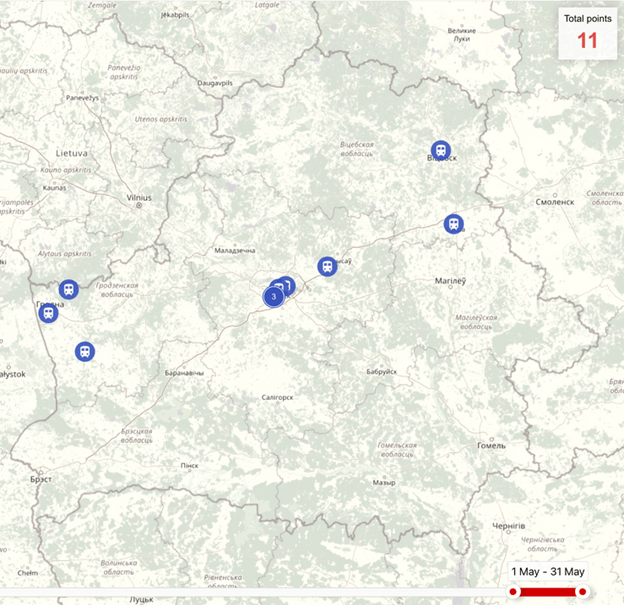
The intensity of movements of the Belarusian Armed Forces by rail decreased almost twofold compared to April. This is connected with a decrease in the number of combat training activities, during which the railroad would be used to redeploy troops.
We recorded movements by rail of the 52nd Tank Battalion of the 6th Mechanized Brigade (connected with the combat readiness inspection). We also recorded the transportation of a significant amount of military equipment in freight trains. Such trains were recorded at the following stations: Ros (with two 122-mm 2S1 Gvozdika self-propelled guns), Stsiapianka, Zhodzina (4 BMP-2 infantry fighting vehicles), and Pamyslishcha.
We should also note that another rotation of units of the 103rd Airborne Brigade, which perform tasks to strengthen protection of the state border with Ukraine, took place from April 28 to May 5. The previous such rotation took place in mid-February 2023. On average, units of the Belarusian Armed Forces stay in the border areas for 2-2,5 months, after which they are rotated.
In addition, after the sabotage of the railroad in Bryansk oblast of Russia, security of the railway infrastructure was significantly strengthened.
1.2.3 Aviation activity.
The intensity of flights of the Belarusian Air Force remained at the same level compared to June. Lida, Baranavichy, and Machulishchy airfields were mainly used for flights of the Belarusian Air Force. Luniniets, Babruisk, Asautsy airfields and Hrodna airport were also used. During the flights, the entire helicopter and aircraft fleet of the Belarusian Air Force was involved.
It’s notable that the Il-76 military transport aircraft of the Belarusian Air Force with the registration number EW-004DE flew to Tehran, the capital of Iran, for 10 days and stayed there from June 26 to July 6. The purpose of the flight is unknown. In general, it may be connected with military-technical cooperation between Iran and the Lukashenko regime, as well as with the preparation for the visit of Belarus’ Defense Minister Viktor Khrenin to Iran.
Four Su-30SM fighters of the Belarusian Air Force were redeployed from Lida airfield to Baranavichy airfield. The aircraft had been at Lida airfield since May 18, 2023, due to the repair of the runway at Baranavichy airfield.
On July 26, Viktor Gulevich, the head of the General Staff of the Belarusian Armed Forces, visited the 116th assault aviation base. During the visit, he inspected the progress of works to improve the base’s infrastructure (storage facilities for aviation weapons, safety and security systems). Judging by the published photos, Gulevich inspected one of the Granit type storage facilities. Some sources note that earlier such facilities were used to store tactical nuclear weapons. Earlier, it was reported that the Su-25 aircraft in service with the 116th assault aviation base had been reequipped to be capable of using tactical nuclear weapons.
1.3. Activity of military commissariats.
Key points on paragraph 1.3:
- The main activities of the military commissariats in May were focused on the completion of spring conscription into the Belarusian Armed Forces, as well as the draft of persons liable for military service for military training sessions.
- Drills with the territorial troops continue to be regularly conducted. Training sessions with reservists of the territorial troops were held in three regions of Belarus in May.
1.3.1 Military and mobilization work.
Military commissariats conducted military mobilization activities in May.
For example, we can note that representatives of military commissariats of Brest region took part in the training on the organization of work of the point of preliminary assembly of persons liable for military service. It was also reported that representatives of military units conducted selection for conscription of reserve officers in the military commissariat of Minsk region. It should be noted that in March 2023, a decree was published under which reserve officers are drafted. And the commission of the military commissariat of Hrodna city and the Hrodna district inspected the readiness of one of the village executive committees to notify and provide mobilization resources.
It can also be noted that military commissariats continued active conscription of persons liable for military service in May (see paragraph 1.1.3 of Chapter 1).
1.3.2 Registration and conscription work.
During conscription for active military service, military commissariats have to face not only a reduction in the number of conscripts, but also another challenge: emigration of young men of conscription age from Belarus. For example, during the spring conscription campaign 2023, 28% of conscripts from the Voranava district didn’t come to the military enlistment office, because they were abroad.
Information about verdicts by the so-called courts for evading conscription activities continues to be reported. One such verdict was reported in May.
1.3.3 Territorial defense. National home guard.
Numerous activities aimed at increasing the capacity of the territorial defense troops were reported in May. First of all, we can mention the ongoing drills of the territorial troops.
For example, from May 11 to June 2, “training sessions with persons liable for military service, aimed at staffing territorial defense bodies and military units of the territorial troops” were held in Homiel, Mazyr district, and Lieninski district of Minsk. The declared program of the training session is standard for this kind of activities. For example, the issues of formation of the territorial troops and their preparation for the performance of tasks for their intended purpose will be worked out at the training session. At the final stage of the training session, the troops will take part in the command staff drills. During the drills, units of the territorial troops will protect life support facilities and ensure public order on the streets of cities together with personnel of the agencies of internal affairs.
It was reported that about 100 people from the reserve were drafted for the drills in Homiel and about 50 people — in the Mazyr district. Persons liable for military service with the following military specializations were drafted for the training session: rifleman, reconnaissance officer, mortar operator, signaller, and driver. The number of reservists in Minsk has not yet been reported. Engineering, firing and medical trainings were held with persons liable for military service. Reservists worked out the issues of security of life support facilities. In general, we can note a low level of firing training of reservists. The training session ended with command staff drills.
It’s important to note that within the framework of the training session, units of the territorial troops were partially staffed. For example, a fire support company of the rifle battalion of the territorial troops was formed with reservists in the Mazyr district.
Other activities include:
Command staff training with the territorial defense authorities took place in the Shchuchyn and Lahoisk districts. Officials of district executive committees, departments of internal affairs and emergency situations were involved in the training.
The military commissariat of Brest and Brest district, Kobryn and Zhabinka districts held trainings with reserve officers assigned to the territorial troops. A representative of the Brest City Department of Emergency Situations took part in the training.
Drills are to be held with the military commissariats of Minsk region from June 21 to June 30. Most likely, it will be dedicated to the topic of territorial defense. The drills will involve 118 servicemen of the military commissariats and 255 conscripts drafted from the reserve.
On May 26, the annual training session “Military security and state defense” was held in Homiel. During the training session, participants learned how to organize and conduct defense of settlements with the support of prepared fortified areas, as well as how to manage territorial defense forces while performing tasks of detecting, blocking and destroying enemy sabotage forces.
The formation of units of the national home guard continued. For example, as part of the combat readiness inspection (see paragraph 1.1.1. of Chapter 1), two units of the national home guard were formed in the Vaukavysk district of Hrodna region (in Ros and Viareiki village), each consisting of 20 people. The units performed tasks of ensuring the safety of movements of military columns, as well as the tasks of maintaining public order.
1.4. Work of the military-industrial complex. Supplies of new samples of military equipment to the troops. Military construction and development of military infrastructure.
Key points on paragraph 1.4:
- New models of communications equipment as well as a set of S-400 SAM systems were put into service with the Belarusian Armed Forces in May.
- The Belarusian Armed Forces won’t receive new Mi-35 helicopters from Russia in the near future.
- The development of border infrastructure on the border with Ukraine continues.
As for the work of the Belarusian military industrial complex, we can note the 11th International Exhibition of Arms and Military Machinery MILEX-2023, which was held on May 17-20. Not only Belarus and Russia, but also Iran and China showed their products at the exhibition. It was reported that the State Committee for Defense Industry signed contracts for a record $265 million at the MILEX-2023 arms exhibition.
It was reported that the Shkval multiple launch rocket system was officially put into service on May 19. However, due to the fact that this MLRS was designed to be sold to foreign customers, it’s unlikely that it will be supplied to the troops in the near future. In this case, putting the MLRS into service is expected to increase its attractiveness for potential foreign customers.
It was reported that new samples of military equipment were supplied to the Belarusian Armed Forces. For example, on May 3, new and modernized communications equipment was supplied. In total, representatives of 13 military units of the Belarusian Armed Forces received 26 samples of new and modernized combined radio stations and operator’s rooms. At least 4 pieces of R-414MBRP Sosna-2 radars produced by AGAT — Control Systems company were among the new equipment transferred. The vast majority of the transferred equipment were communications equipment on ZiL-131 and KamAZ-4310 chassis (at least 15 pieces). It should be noted that new and modernized communications equipment is transferred twice a year. Previously the transfer of equipment took place at the end of November 2022.
On May 28, the Belarusian Armed Forces received another set of anti-aircraft missile systems. At least three launchers of S-400 SAM systems, as well as auxiliary equipment, were delivered to Belarus. Currently, there is no information about which unit of the Belarusian Armed Forces will receive the new weapons. We recall that in December 2022, Lukashenko already announced that Russia would transfer a complete set of S-400 SAM systems to Belarus. However, the Ministry of Defense of Belarus hasn’t demonstrated this equipment so far.
It was also reported that more than 1000 UAVs of various modifications and purposes have already been purchased for the needs of the internal troops. UAVs are also being procured for the Belarusian border guard agencies.
It should be noted that despite the supply of new equipment to the troops, it’s not always used in combat training. For example, despite the transfer of a large batch of individual first aid kits to the 103rd Airborne Brigade, conscripts are not taught how to use them.
It should also be noted that the leadership of the Ministry of Defense of Belarus stopped mentioning possible deliveries of the first batch of four Mi-35 helicopters made in Russia to the troops. From this we can conclude that the supply of these helicopters has been at least postponed indefinitely, if not completely cancelled.
Speaking about military construction and development of military infrastructure, we can note the formation of a new type maneuver group (based on the Soviet model) in the Mazyr border guard detachment in 2022, which consists of three outposts (with about 300 people). It’s armed with armored vehicles and mortar groups. This year, maneuver groups will be formed at the Lida border detachment and Brest border guard group. Also, the construction of a new border outpost in the Homiel direction will be completed by the end of 2023, the construction of four more outposts has been started.
As for the development of military infrastructure, we should mention the installation of a line of anti-tank fortifications Dragon’s teeth in the Homiel district. Previously, the Dragon’s teeth produced by Belarusian companies were mainly supplied to Russia and weren’t used to create fortified areas on the territory of Belarus. The total length of the fortification line is 2 kilometers. The fortified area itself was created for training purposes to demonstrate it to the participants of the “Military security and state defense” training session (see paragraph 1.3.3 of Chapter 1).
1.5.Amendments to the legislation in the military sphere.
Key points on paragraph 1.5:
- Conditions continue to be created for the conscription of more soldiers into the active service in the Belarusian Armed Forces, as well as expanding opportunities for students in higher education institutions to take military training classes.
- Belarus and Russia are legally strengthening cooperation in the military sphere.
As for legislative innovations related to national security, we can note the following:
- Belarus has ratified the Program of military-technical cooperation with Russia until 2025. The relevant law was published on the National legal internet portal.
- Amendments to the Law “On military duty and military service” were approved. According to the amendments, the deferment from active military service for citizens studying abroad was abolished. The possibility of serving under a contract in the law enforcement agencies instead of active military service was also significantly reduced. Due to the emigration processes in the country, potential conscripts prefer studying abroad and not coming back to Belarus for active military service.
- On September 1, 2023, a military department will be opened at Polatsk State University. The relevant changes were made in the decree of the Council of Ministers of the Republic of Belarus No. 1469 of 05.11.2003. Military departments provide military training to students of civilian educational institutions under programs for junior commanders (sergeants) and reserve officers.
- A draft law “On ratification of the Protocol between the Republic of Belarus and the Russian Federation on amendments to the Agreement between the Republic of Belarus and the Russian Federation on joint provision of regional security in the military sphere of December 19, 1997” was passed in one reading. Provisions of the Protocol allow for the dislocation of military units of the Russian part of the regional group of troops and military infrastructure facilities of the Russian Armed Forces that provide for their operation.
- A normative legal act was prepared to regulate initial military training with students of higher education institutions.
1.6. Transfer of weapons, ammunition, and military gear by the Lukashenko regime to Russia.
Key points on paragraph 1.6:
- No facts of the transfer of military equipment and ammunition by the Lukashenko regime to Russia were recorded in May.
No new reliable facts of the transfer of military equipment and ammunition to Russia by the Lukashenko regime were recorded in May. This indicates that the equipment and ammunition at the disposal of the Belarusian Armed Forces are limited, and during a full-scale invasion, these resources could have been partially spent. For more information, see the document dated March 14, 2023 “Serving the Kremlin’s military order: how did the Lukashenko regime get involved in supplying the Russian Armed Forces?”
1.7. Tactical nuclear weapons in Belarus.
Key points on paragraph 1.7:
- The legal procedure for maintaining TNW on the territory of Belarus was completed in May.
- At the moment, the procedure and conditions for storing TNW in Belarus are unknown.
- Taking into account Russia’s statements about not transferring control over TNW to the Lukashenko regime, we can expect the establishment of a new military base of the Russian Armed Forces in Belarus, which will be responsible for the protection and use of TNW.
In May, activities on the preparation for the transfer of tactical nuclear weapons (hereinafter — TNW) to Belarus continued.
For example, on May 25, Belarusian and Russian Defense Ministers Viktor Khrenin and Sergey Shoigu signed documents on the storage of Russian non-strategic nuclear weapons on the territory of Belarus. The content, as well as the status of the signed documents, is currently unknown.
Despite Lukashenko’s previous statements, the Russian party publicly stresses that Belarus won’t receive control over nuclear weapons. This means that a new Russian military base will actually be established on the territory of Belarus, which will control the safety of TNW.
According to Lukashenko, the transfer of TNW to the territory of Belarus has already begun. This information hasn’t yet been confirmed.
It was also reported that units of the Belarusian Armed Forces are already training to conduct nuclear missile strikes (see paragraph 1.1.1 of Chapter 1).
For more information about possible locations for TNW deployment, see the document dated April 4, 2023, “Where a tactical nuclear weapons storage may be built in Belarus?”
Chapter 2. The Armed Forces of the Russian Federation (hereinafter – the Russian Armed Forces)
2.1. Deployment of the regional group of troops.
Key points on paragraph 2.1:
- About 4500 servicemen of the Russian Armed Forces could be stationed at the training grounds and airfields of the Belarusian Armed Forces.
- The withdrawal of equipment and personnel of the Russian Armed Forces from Belarus was recorded. According to our estimates, in total, at least 109 pieces of military equipment and about 540 personnel could have been withdrawn from Belarus.
- The transfer of equipment and personnel of the Russian Armed Forces from Russia was recorded. According to our estimates, at least 164 pieces of military equipment and about 864 personnel could have been transferred to Belarus.
2.1.1 Rotation of personnel and equipment of the Russian Armed Forces in Belarus.
The intensity of the transfer of Russian troops to the territory of Belarus increased in May compared to April. We noted both the withdrawal of personnel and military equipment of the Russian Armed Forces from the territory of Belarus and their transfer to Belarus. These movements mainly took place by rail.
We recorded the following military cargo trains withdrawing equipment and personnel of the Russian Armed Forces from Belarus:
- On May 14, a military cargo train left Asipovichy-1 station. 4 passenger cars and 5 freight cars (they were loading ammunition into them), at least 24 pieces of equipment (30 152-mm Msta-B howitzers and 4 vehicles). A large number of Russian servicemen of various ages dressed in new uniforms were seen at the station.
- On May 14, a military cargo train left Palonka station for Gukovo station (Rostov oblast, Russia): 3 passenger and 2 freight cars, at least 40 pieces of wheeled and tracked vehicles.
- On May 17, a military cargo train left Zaslonava station for Gukovo station (Rostov oblast, Russia): 3 passenger and 2 freight cars, at least 35 pieces of wheeled and tracked vehicles.
In total, at least 3 military cargo trains with equipment and personnel of the Russian Armed Forces left Belarus in May: 109 pieces of wheeled and tracked vehicles, ≈540 personnel.
We recorded the following military cargo trains transferring equipment and personnel of the Russian Armed Forces to Belarus:
- On May 18, a military cargo train arrived at Zaslonava station from Volnovakha station (Donetsk oblast, Ukraine): 4 passenger and 2 freight cars, at least 39 pieces of wheeled and tracked vehicles.
- On May 15 and 16, two military cargo trains arrived at Palonka station: 8 passenger and 3 freight cars, at least 75 pieces of wheeled and tracked vehicles.
- On May 22, a military cargo train arrived at Liasnaya station from Yelnia station (Smolensk oblast, Russia): 2 passenger cars and at least 20 pieces of wheeled and tracked vehicles.
- On May 22, a military cargo train arrived at Zaslonava station from Volnovakha station (Donetsk oblast, Ukraine): no data on the number of personnel and military equipment.
In total, at least 5 military cargo trains with equipment and personnel of the Russian Armed Forces arrived in Belarus in May: 164 pieces of wheeled and tracked vehicles, ≈864 personnel.
We note that the data about at least 2 military cargo trains spotted in Orsha on May 23 and May 25 couldn’t be confirmed at the moment.
So, more Russian military arrived in Belarus in May than went to the combat zone. It’s remarkable that the withdrawal of units of the Russian Armed Forces from Belarus to Russia and the combat zone in Ukraine prevailed in February-April 2023. We recall that during the visit of Russian Defense Minister Sergey Shoigu to Minsk on April 10, the expansion of the framework for the training and stay of the Russian component of the regional group of troops in Belarus was discussed with Lukashenko. We may assume that the increase in the number of Russian servicemen who arrived in Belarus in May was a consequence of the negotiations mentioned above. It’s important to note that there are currently fewer Russian military in Belarus than there were in fall 2022-winter 2023.
Thus, we can state that another wave of rotation of the contingent of the Russian Armed Forces stationed in Belarus began on May 12. As before, the rotation is as follows: trained Russian units are sent from Belarus to the combat zone, and Russian servicemen (mobilized, volunteers) arrive from Russia to train at the training ranges of the Belarusian Armed Forces. At the moment, we can preliminary state that the May rotation of the Russian Armed Forces was completed on May 22-25.
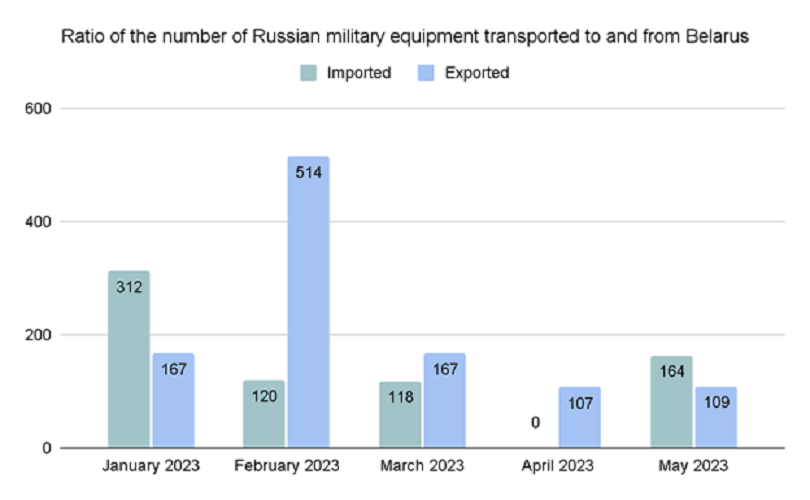
We recall that previously we have already recorded two major rotations of the Russian contingent stationed in Belarus. These rotations took place in: January (the main phase was from January 5 to January 14) and February-March (the main phase was from February 24 to March 4). Previously, the Lukashenko regime had publicly confirmed that the Russian military was in Belarus on a rotational basis.
We note that the military cargo trains departed from Asipovichy-1 station (Asipovichski training ground), Zaslonava station (Liepielski training ground), and Palonka station (Obuz-Liasnouski training ground), and arrived at Palonka station (Obuz-Liasnouski training ground) and Zaslonava station (Liepielski training ground). Thus, we can expect that the training of the Russian military is currently most intense at these training ranges.
It should be noted that according to government procurement data for 2023, expenditures on the purchase of waste removal services increased significantly at the Liepielski and Obuz-Liasnouski training grounds. We may assume that the increase in expenditures is primarily connected with the permanent deployment (since October 2022) of the Russian military. In this regard, we can state that the Russian military will stay in Belarus at least until the end of 2023.
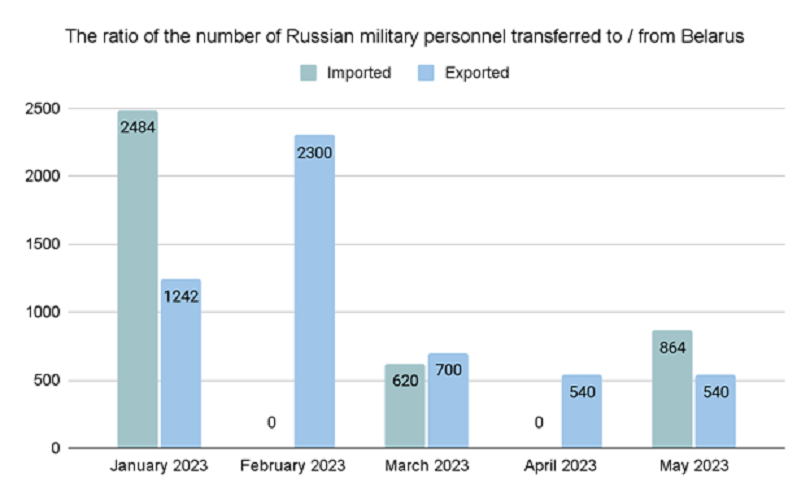
We also recorded movements of columns with military equipment of the Russian Armed Forces along the M1 highway (section of the border with Russia-Orsha). We may assume that these columns with equipment arrived in Belarus by public roads. However, rail transport remains the main way of delivering personnel and military equipment to Belarus.
Based on all of the mentioned above, we may assume that there has been a slight increase in the number of Russian servicemen included in the regional group of troops stationed in Belarus. However, this increase is primarily connected with the buildup of trained reserves, rather than with preparations for a new offensive operation from the territory of Belarus.
2.1.2 Estimates of the Russian contingent included in the regional group of troops.
As of early May, we estimated the number of Russian military personnel that could have currently been stationed on the territory of Belarus at about 4000 people. More details on the calculation methodology can be found following the link.
Based on data from satellite images, we may assume that as of the beginning of June, the following number of the Russian contingent could be stationed in Belarus:
- The 230th combined arms training ground Obuz-Liasnouski: about 226 residential tents (5 USB-56, 22 M-10, 199 M-30), 100 pieces of military equipment (as of May 9).
- Lasvida training ground of the 103rd Airborne Brigade: about 78 residential tents and 10 pieces of military equipment (as of March 20).
- Asipovichski training ground of the 51st Artillery Brigade (Repishcha): about 44 residential tents (1 USB-56, 5 M-10, 38 M-30), 42 pieces of military equipment (as of May 9).
- Liepielski training ground of 19th Mechanized Brigade: about 95 residential tents, 73 pieces of military equipment (as of March 19).
- Brestski training ground of the 38th Air Assault Brigade: about 53 residential tents, 77 pieces of military equipment (as of March 19).
The assessment of the size of the Russian contingent stationed in Belarus is complicated by the fact that the number of residential tents at the training grounds can’t match the number of military personnel stationed at the training grounds, since tent camps have been unchanged for a long time. Based on the available data (primarily on the rotation of the Russian contingent in May), we can estimate the number of servicemen of the Russian Armed Forces stationed in Belarus at around 4500 people. This estimate is based, among other things, on the number of military equipment and personnel of the Russian Armed Forces withdrawn (brought) in May (see paragraph 2.1.1 of Chapter 2).
We recall that earlier the Ministry of Defense of Belarus stated that the size of the Russian contingent in the regional group of troops would not exceed 9 thousand people. It’s important to note that the number of the Russian military in Belarus is not static and is constantly changing. The Russian military are also permanently stationed on the territory of Belarus at the airfield in Vialiki Bokau and Ziabrauka airfield (see paragraph 2.4 of Chapter 2), as well as at Machulishchy, Baranavichy and Lida airfiels (see paragraph 2.2.3 of Chapter 2).
We note that the Russian military are mainly stationed at the training grounds of the Belarusian Armed Forces in northern and central Belarus, at a distance from the border with Ukraine.
2.1.3 Combat training of the regional group of troops.
The Russian and Belarusian propaganda didn’t report on combat training of the Russian military at the training grounds in Belarus during the month. There were also almost no reports about joint combat training of units of the Russian and Belarusian Armed Forces (see paragraph 1.1.1 of Chapter 1).
The available information on combat training of the Russian military can be found in the review of the main military events in Belarus for April 2023.
2.1.4 Daily activities of the Russian military.
In general, the situation with the daily activities of the Russian military didn’t change significantly in May. The locations where Russian servicemen were spotted didn’t change significantly compared to previous months.
Servicemen of the Russian Armed Forces are often spotted in cities and towns located near the training grounds of the Belarusian Armed Forces. During the month, Russian servicemen were spotted in Baranavichy and Baranavichy district, Mazyr, Kobryn, Asipovichy and Zaslonava village.
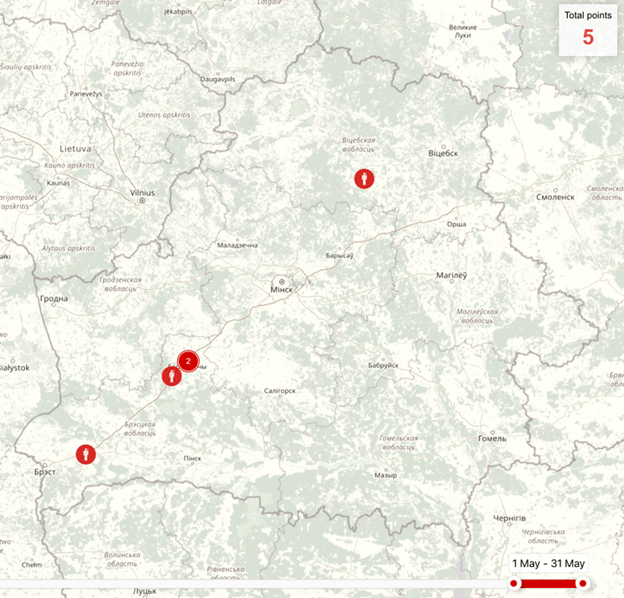
Most often, the Russian military visit shopping centers, grocery stores, household stores and pharmacies on weekends.
2.2 Movements of military equipm
Key points on paragraph 2.2:
- The decrease in the intensity of movements of columns of military equipment of the Russian Armed Forces compared to April 2023 is a consequence of the withdrawal of part of the Russian troops from Belarus.
- There were almost no movements of equipment of the Russian Armed Forces recorded in the areas bordering Ukraine. This means that Russia is not yet planning a military operation from the territory of Belarus.
- The level of movements of the Russian Armed Forces by rail increased compared to April due to a new wave of rotation.
- The regrouping of the Russian Aerospace Forces stationed in Belarus took place in May.
2.2.1 Movements of military and combat equipment by road.

The intensity of movements of both military and combat equipment of the Russian Armed Forces decreased twofold compared to April. There were almost no recorded columns of combat equipment. The decrease in the intensity of movements of military equipment of the Russian Armed Forces is a consequence of previous rotations and the withdrawal of a significant part of military equipment from Belarus. At the same time, more military equipment was brought to Belarus than was withdrawn to Russia in May (see paragraph 2.1.1 of Chapter 2). In this regard, we can expect an increase in the intensity of movements of the Russian Armed Forces.
The highest activity of movements of military equipment were recorded in Brest region (on the M1 highway), Homiel region (on the M5, M8 highways, near Homiel and Mazyr), in Minsk region (on the M1, M3 highways and near Minsk), as well as in Vitsiebsk region (on the M1, M3 highways). Almost no equipment of the Russian Armed Forces was recorded in the areas of Belarus bordering Ukraine.
The main routes of movements of equipment: Minsk-Baranavichy, Asipovichy-Minsk, Minsk-Orsha, Minsk-Biahoml, etc. Military vehicles were also spotted in the following towns and cities: Minsk, Mazyr, Brest, Homiel, and Maladziechna. More detailed dynamics of movements of equipment of the Russian Armed Forces can be seen on our interactive map.
Most of the vehicles of the Russian Armed Forces had license plates with region 50 and 51 (Western Military District of the Russian Armed Forces). Vehicles of the Russian Armed Forces were also often moving without license plates.
Movements of Russian fuel trucks, which were recorded 6 times in May, are still active. Most of the fuel trucks were recorded on the M1 and M3 highways. We can also note the change in the location of movements of fuel trucks of the Russian Armed Forces to the northern regions of Belarus (Minsk and Vitsiebsk regions). This may indicate a relocation of the main training center of the Russian military in Belarus to the Liepielski training ground.
2.2.2 Movements of troops by rail.
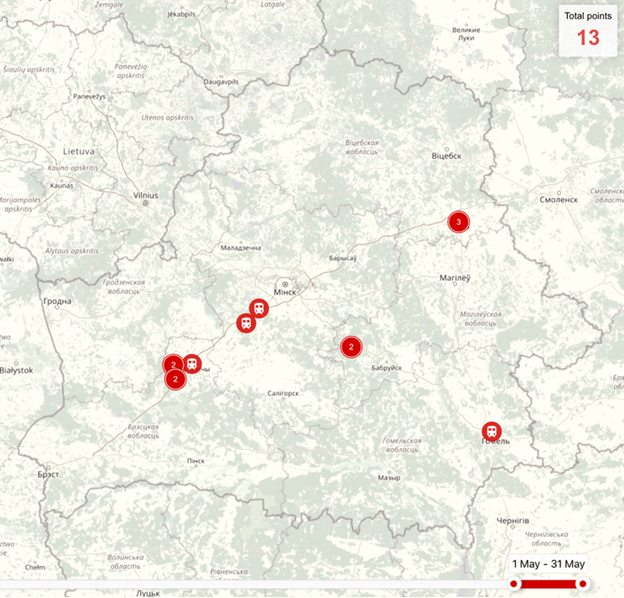
The intensity of movements of the Russian Armed Forces by rail increased twofold compared to April. This is connected with another rotation of part of the Russian contingent included in the regional group of troops stationed in Belarus.
During the month, we recorded the arrival of at least 3 military cargo trains with equipment and personnel of the Russian Armed Forces to Belarus, and the departure of at least 5 more military cargo trains (see paragraph 2.1.1 of Chapter 2).
There were two routes for transporting military cargo trains to Belarus from Russia / from Belarus to Russia: through Orsha and further to Smolensk, through Homiel and further to Bryansk.
In general, we can note that movements of the Russian Armed Forces by rail are episodic, rather than systemic in nature. The nature of the railroad movements makes it possible to state that there is no accumulation of forces and means for conducting offensive operations from the territory of Belarus.
2.2.3 Aviation activity.
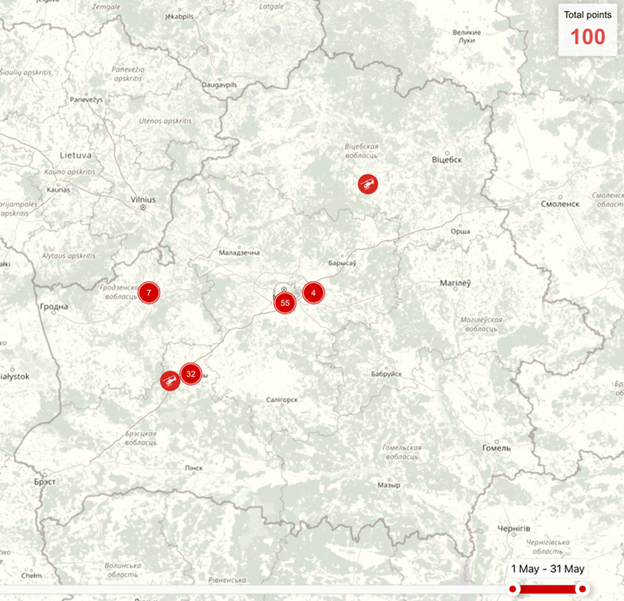
The intensity of flights of the Russian Aerospace Forces decreased slightly compared to April. The decrease in flight activity was caused by the complete absence of arrivals of military transport aircraft of the Russian Aerospace Forces at Homiel airport.
As of June 1, 2023, the aviation group of the Russian Aerospace Forces in Belarus included:
- bombers: 8 pieces of Su-34 and 2 pieces of Su-24MR (stationed at Machulishchy and Lida airfields, respectively);
- fighters: 2 pieces Su-30SM of the 14th Fighter Aviation Regiment (stationed at Machulishchy airfield);
- helicopters: 12 pieces of Mi-8, Mi-24 and Mi-28 (stationed at Baranavichy airfield).
After the end of the military Airforce drills of the Belarusian and Russian Armed Forces on February 1, a significant part of the helicopters and aircraft of the Russian Aerospace Forces mentioned above stayed at the airfields of the Belarusian Armed Forces.
The aviation group of the Russian Aerospace Forces was relocated to new airfields in May. On May 18, helicopters were relocated from Machulishchy airfield to Baranavichy airfield, and aircraft — from Baranavichy airfield to Machulishchy and Lida airfields. The probable reason for the relocation of aircraft is repair work on the runways of the airfields. As of the end of May, such work began at Baranavichy airfield.
For more information about the rotation, see the document dated May 19, 2023, “Russia has regrouped its aviation forces deployed in Belarus.”
Arrivals of military transport and passenger aircraft of the Russian Aerospace Forces at Belarusian airfields (airports) continued. The aircraft arrived at:
- Baranavichy airfield: transport — 1 An-12, 1 An-12BK, 3 An-26;
- Machulishchy airfield: passenger — 2 An-148, 1 Tu-214; transport — 6 Il-76 and 1 An-26;
- Minsk National Airport: passenger — 2 Tu-214 of the Federal Security Service of Russia;
- Lida airfield: An-26Sh (RF-36034, trainer aircraft for initial training of navigators).
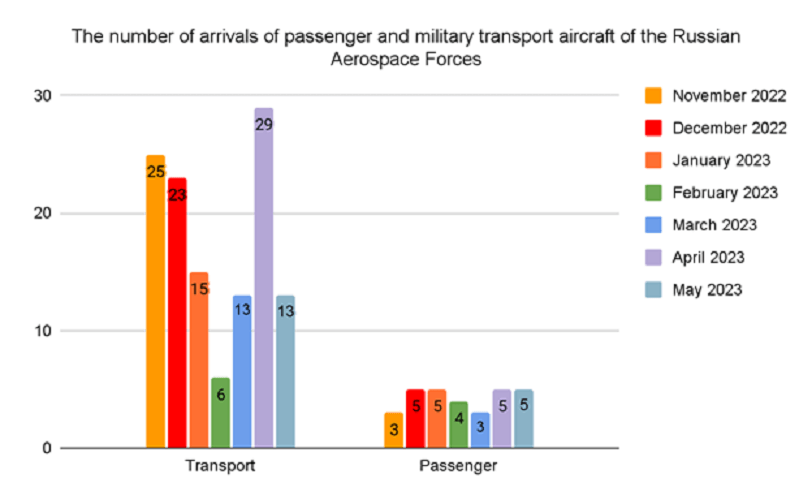
We can note that the number of arrivals of military transport aircraft decreased by more than two times in May compared to April, while the number of arrivals of passenger aircraft remained at the same level. As noted above, the decrease in the activity of military transport aircraft was caused by their complete absence at Homiel airport. However, according to our data, a new burst of arrivals of military transport aircraft of the Russian Aerospace Forces at Homiel airport should be expected in June-August.
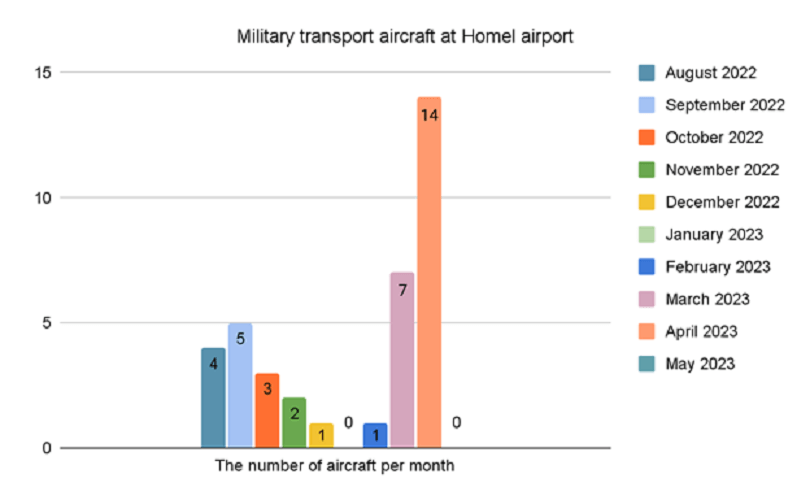
For more information, see the document dated March 31, 2023, “Mass arrivals of military transport aircraft in Homiel, a Russian general visits Ziabrauka airfield. What’s going on?”
2.3. Missile strikes from the territory of Belarus.
Key points on paragraph 2.3:
- The threat of missile strikes from the territory of Belarus by ground-based and air-based systems remains.
- The withdrawal of MiG-31K aircraft from Belarus decreases the ability of the Russian Armed Forces to launch strikes with air-to-surface missiles.
- If necessary, the group of the Russian Aerospace Forces stationed in Belarus, as well as anti-aircraft missile systems of the Russian Armed Forces, can be used to launch missile strikes.
In May, no missile strikes from the territory of Belarus were recorded. We note that the last missile strike at the territory of Ukraine from the territory of Belarus was launched on October 6, 2022.
The withdrawal of MiG-31K fighter-interceptors capable of using Kinzhal hypersonic missiles from the territory of Belarus in April 2023 reduces the possibility of air-based missile strikes. At the same time, Su-34 and Su-24MR bombers, as well as Su-30SM fighters, which can be used for missile strikes against the territory of Ukraine if needed, remain at Machulishchy and Lida airfields. We should also keep in mind that anti-aircraft missile systems of the Russian Armed Forces are stationed at the airfield in Vialiki Bokau and Ziabrauka airfield (see paragraph 2.4 of Chapter 2), which can also be used to launch missile strikes.
It is also worth noting that the restriction zone for flights of all types of civil aircraft (including UAVs) at altitudes from 0 to 19,800 meters in the south of Belarus, extended according to NOTAMN O0230/23, remains until July 1, 2023. The ban on flights over the southern part of Belarus was introduced on February 24, 2022.
The facts mentioned above once again confirm the existence of a permanent threat of missile strikes from the territory of Belarus.
2.4. Functioning of military bases at Ziabrauka airfield and the airfield in Vialiki Bokau.
Key points on paragraph 2.4:
- The Russian Armed Forces continue to use their military facilities in the southern regions of Belarus. Currently, there are no signs that this activity will stop.
- A military base of the Air Defense Forces of the Russian Armed Forces is deployed at the airfield in Vialiki Bokau village (Mazyr district).
- No changes in the number of equipment of the Russian Armed Forces were recorded at Ziabrauka airfield.
Russian equipment and servicemen were repeatedly spotted in and near Mazyr in May. This is indirect evidence of the presence of the Russian military at the airfield in Vialiki Bokau village(Mazyr district).
According to the satellite images dated May 6, the following military equipment of the Russian Armed Forces was stationed at the airfield:
- 8 launchers of S-300/400 SAM system;
- 1 Pantsir-S1 self-propelled anti-aircraft gun and missile (SPAAGM) system;
- 3 5Т58 transport semi-trailer vehicles of S-300/400 SAM system;
- 1 armored personnel carrier;
- 18 trucks;
- 1 92N6 radar;
- 1 91N6 surveillance and tracking radar;
- 1 76N6 radar on the 40V6M universal mobile tower;
- 1 96L6E all-altitude detector on the 40V6 universal mobile tower;
- 6 pieces of unidentified military equipment;
- 8 mockups of military equipment (6 of them are S-300/400 SAM systems);
- 10 unknown objects under the camouflage net;
- 11 tents (1 USB-56, 1 UST-56, 4 М-10, 5 М-30, the total capacity is about 300 people).
Thus, the Russian Armed Forces use the territory of the airfield for their own purposes.
There was no new information about the condition of the Russian military base at Ziabrauka airfield. Information about the deployment of military equipment at the airfield is given in the table below.
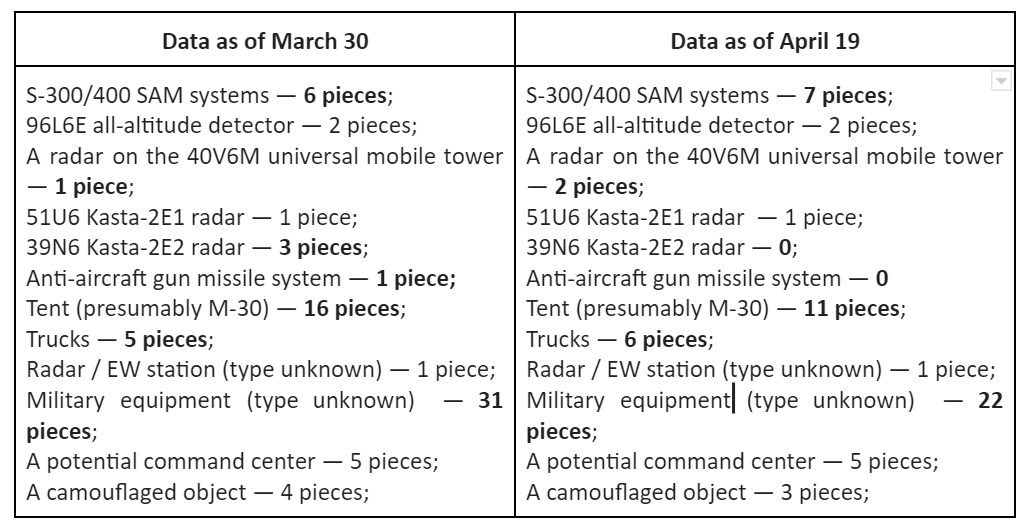
The airfield is still occupied by the Russian military without any legal status (such as a military base of the Russian Armed Forces, etc.). All this indicates that the Russian Armed Forces are planning to continue operating Ziabrauka airfield.
Chapter 3. General conclusions.
1. The Belarusian Armed Forces continue to actively adopt the experience of the war in Ukraine. It’s not only about introducing new tactics into combat training, but also about mobilization and the development of a system of the territorial troops. All the constituent elements of national security are constantly inspected.
Currently, there is no evidence that the Lukashenko regime is preparing its forces for joint participation with the Russian Armed Forces in combat operations against Ukraine. The Belarusian Armed Forces are still incapable of conducting an offensive operation against Ukraine on their own. There are still no reasons to believe that the Belarusian Armed Forces will be involved in combat operations in Ukraine in the medium term.
2. Nothing new happened in the activity of the Russian Armed Forces on the territory of Belarus during the month. The forces and means are still concentrated at the training grounds of the Belarusian Armed Forces, far from the border with Ukraine. The main purpose of the deployment of the regional group of troops is still the training of the Russian military at the training grounds of the Belarusian Armed Forces for their further participation in combat operations in Ukraine. The presence of the Russian Armed Forces in Belarus creates an illusion of a possible repeat offensive from the territory of Belarus, which restrains part of the Ukrainian forces on the border with Belarus.
In general, we can note a change in the trend from a decrease in the number of Russian group in Belarus to a stabilization of its size. At the same time, the number of Russian servicemen can grow at any moment.
The number of the Russian contingent in Belarus shows that the Russian Armed Forces have no task to accumulate their forces in Belarus. As a consequence, Russia is not planning an offensive operation from the territory of Belarus in the short term. Therefore, the most probable scenario is currently Scenario 3. Belarus is a permanent training base for the Russian military.
Note. Scenario 3. Belarus is a permanent training base for the Russian military. In this scenario, Russian servicemen (mostly mobilized Russians) will arrive at the training grounds in Belarus, pass a course of military training, and leave for the combat zone. New mobilized soldiers will arrive instead. Its implementation is currently indicated by the following:
- Periodic intensification of movements of the Russian military by rail to/from Belarus.
- Lack of redeployment of military equipment of the Russian Armed Forces to the training grounds in Belarus (except the rotation of personnel).
- Regular extension of drills period at the training grounds of the Belarusian Armed Forces.
The key destabilizing factor that could change the current military situation in Belarus is still the possible deployment of TNW on the territory of Belarus.

